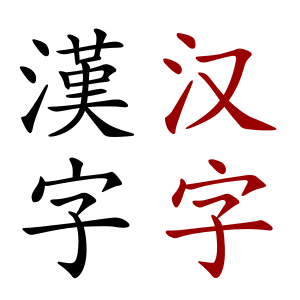Traditional Chinese characters facts for kids
Traditional Chinese characters are one of the two main ways to write Chinese characters. They are the "traditional" written form of the Chinese language. This writing style first appeared during the Han Dynasty (around 206 BC). The name "traditional" helps tell them apart from simplified Chinese characters.
During the Han Dynasty, government officials found that the small seal script characters were too slow to write. These older characters, standardized by Emperor Qin Shi Huangdi, used many curved lines. So, Han officials decided to make writing easier. They started using more straight lines and multiple strokes to form characters and their parts, called radicals. These changed characters became known as Hanzi (meaning "Han characters"). They were named after the Han Dynasty. Hanzi became the main writing system for Chinese. It even spread to other countries and languages. For example, it was used (with some changes) in Japanese, Korean, and Vietnamese.
Today, Japanese is the only non-Chinese language that still uses Chinese characters daily. They call them Kanji. After World War II, the Japanese made many characters simpler. They called their simpler characters Shinjitai. The older, traditional characters were called Kyujitai.
The older, "traditional" Chinese characters stayed mostly the same for a long time. But then, the People's Republic of China (PRC) was formed in 1949. The Communist Party of China (CPC) began to create simplified Chinese characters. About 20-30% of everyday Chinese characters were replaced with ones that had fewer strokes. This made them easier to write. This change happened in the 1950s across Mainland China. The goal was to make education more available to everyone, especially farmers.
At the same time, the government of the Republic of China, which had moved to Taiwan, chose to keep using traditional Chinese characters. They believed that simplified characters removed important details from the traditional ones. The Cantonese-speaking areas of Hong Kong and Macau also kept using traditional characters. This is true even though they are governed by the PRC, which uses simplified characters. Chinese taught as a second language in Southeast Asia often uses simplified characters. The government of Singapore and the Chinese community in Malaysia have also adopted simplified characters. However, many immigrant communities of overseas Chinese often prefer to use traditional characters.
Traditional vs. Simplified Characters
Here is a list showing simplified characters next to their traditional versions.
| Traditional | Simplified | Pinyin | Meaning |
|---|---|---|---|
| 馬 | 马 | mǎ | horse |
| 鳥 | 鸟 | niǎo | bird |
| 鶏 | 鸡 | jī | chicken |
| 華 | 华 | huá | magnificent / China |
| 國 | 国 | guó | country / nation / state / kingdom |
| 聽 | 听 | tīng | listen / hear |
| 強 | 强 | qiáng | strong |
| 無 | 无 | wǔ | nothing |
| 麵 | 面 | miàn | noodles |
| 話 | 话 | huà | speak / speech / talk |
| 銀 | 银 | yín | silver |
| 飮 | 饮 | yĭn | drink |
| 豿 | 狗 | gŏu | dog |
| 殺 | 杀 | shā | kill |
| 長 | 长 | cháng | long / length |
| 雲 | 云 | yùn | cloud |
Related Pages
Images for kids
-
The east square of Guangzhou railway station in 1991. Notice the prevalence of traditional Chinese characters as brand logos during that time, including Jianlibao (健力寶), Rejoice (飄柔) and 萬家樂, only Head & Shoulders (海飞丝) printed in simplified. In Mainland China, it is legal to design brand logos in traditional characters, yet by 2020, apart from Jianlibao, the other three have changed to simplified.
See also
 In Spanish: Caracteres chinos tradicionales para niños
In Spanish: Caracteres chinos tradicionales para niños




